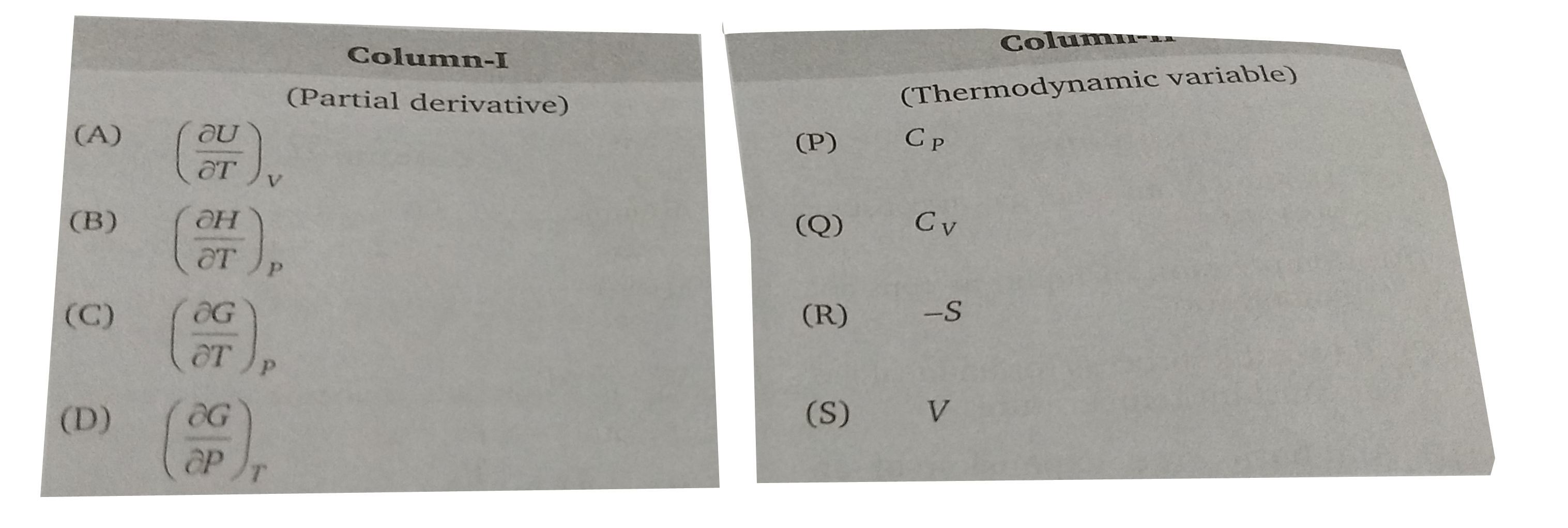The fat, C57H104O6(s), is metabolized via the following reaction. Given the enthalpies of formation, calculate the energy (kJ) liberated when 1.0 g of this fat reacts.
C57H104O6(s)+80O2(g)→57CO2(g)=−52H2O(l)
ΔfH∘(C57H104O6,s)=−70870 kJ/mol, ΔfH∘(H2O,l)=−285.8 kJ/mol,
ΔfH∘(CO2,g)=−393.5 kJ/molSolution in Punjabi
37.98
40.4
33.4
30.2
The correct Answer is:A
ΔrH∘=57×(−393.5)+52×(−285.8)−(−70870)
=−33578.9 kJ/mol
=−33578.9884=−37.98 kJ/mol
Topper's Solved these Questions
- BOOK - NARENDRA AWASTHICHAPTER - THERMODYNAMICSEXERCISE - Level 3 - One Or More Answers Are Correct1videos
THERMODYNAMICS
- BOOK - NARENDRA AWASTHICHAPTER - THERMODYNAMICSEXERCISE - Level 3 - Match The Column2videos
THERMODYNAMICS
- BOOK - NARENDRA AWASTHICHAPTER - THERMODYNAMICSEXERCISE - Level 2 (Q.1 To Q.30)1videos
THERMODYNAMICS
- BOOK - NARENDRA AWASTHICHAPTER - STOICHIOMETRYEXERCISE - Level 3 - Subjective Problems20videos
STOICHIOMETRY
Similar Questions
Assume ideal gas behaviour for all the gases considered and neglect vibrational degrees of freedom. Separate equimolar sample. Separate equimolar samples of Ne, O2 , CO2 and SO2 were subjected to a two process as mentioned. Initially all are at same state of temperature and pressue.
Step I → All undergo reversible adiabatic expansion to attain same final volume, which is double the original volume thereby causing the decreases in their temperature.
Step → After step I all are given appropriate amount of heat isochorically to restore the original temperature.
Mark the correct option(s) :13:11View SolutionMatch the following columns
 05:40View Solution
05:40View SolutionWrite structure of 2,2-dimethylheptane.
04:02View SolutionWhat volume of a liquid (in L) will contain 10 mole ? If molar mass of liquid is 280 and its density is 1.4 g/mL.
03:01View SolutionCalculate the enthalpy of combustion of benzene (l) on the basis of the following data: a. Resonance energy of benzene (l) =- 152 kJ// mol b. Enthalpy of hydrogenation of cyclohexene (l) =- 119 kJ//mol c. Delta_(f)H^(Theta)C_(6)H_(12)(l) =- 156 kJ mol^(-1) d. Delta_(f)H^(Theta) of H_(2)O(l) =- 285.8 kJ mol^(-1) e. Delta_(f)H^(Theta)of CO_(2)(g) =- 393.5 kJ mol^(-1)
View SolutionCalculate the standard Gibbs free energy change from the free energies of formation data for the following reaction:
C6H6(l)+152O2(g)→6CO2(g)+3H2O(g)
Given that ΔfGΘ=[C6H6(l)]=172.8kJmol−1
ΔfGΘ[CO2(g)]=−394.4kJmol−1
ΔfGΘ[H2O(g)]=−228.6kJmol−103:28View SolutionDetermine the enthalpy of formation of B_(2)H_(6) (g) in kJ/mol of the following reaction : B_(2)H_(6)(g)+3O_(2)(g)rarrB_(2)O_(3)(s)+3H_(2)O(g) , Given : Delta_(r )H^(@)=-1941 " kJ"//"mol", " "DeltaH_(f)^(@)(B_(2)O_(3),s)=-1273" kJ"//"mol," DeltaH_(f)^(@)(H_(2)O,g)=-241.8 " kJ"//"mol"
02:49View SolutionWhen 2 moles of C2H6(g) are completely burnt 3120 kJ of heat is liberated. Calculate the enthyalpy of formation, of C2H6(g). Given ΔfH for CO2(g) & H2O(l) are −395 & −286 kJ respectively.
View SolutionFind the enthalpy of S−S bond from the following data.
(i)C2H5−S−C2H5(g)ΔfH∘=−147.2 kJ/mol(ii)C2H5−S−S−C2H5(g)ΔfH∘=−201.9 kJ/mol(iii)S(g)ΔfH∘=222.8 kJ/molView SolutionCalculate the DeltaH_(f)^@ of C_(6)H_(12)O_(6) (s) from the following data: DeltaH_(comb)[C_(6)H_(12)O_(6)(s)]=-2816.kJ//mol DeltaH_(f)^(@) of CO_(2)(g)=-393.5kJ//mol DeltaH_(f)^(@) of H_(2)O(l)=-285.9kJ//mol
02:35View SolutionWith the help of a thermochemical equation, calculate Delta_(f)H^(@) at 298 K for the following reactions : "C(graphite)" + O_(2)(g) rarr CO_(2)(g) , Delta H = -393.5 kJ//mol H_(2)(g) + (1)/(2)O_(2)(g) rarr H_(2)O(l) , Delta_(f)H^(@) = -285.8 kJ//mol CO_(2)(g) + 2H_(2)O(l) rarr CH_(4)(g) + 2O_(2)(g) , Delta_(f)H^(@) = +890.3 kJ//mol
04:54View SolutionFrom the following data at 25^(@) C {:("Reaction" ,, Delta_(r) H^(@) kJ//mol) , ((1)/(2) H_(2) (g) + (1)/(2) O_(2) (g) to OH (g) ,, 42), (H_(2) (g) + (1)/(2) O_(2) (g) to H_(2) O (g) ,, -242), (H_(2) (g) to 2 H (g) ,, 436) , (O_(2) (g) to 2 O(g) ,, 495):} Which of the following statement(s) is/are correct : Statement(a) : Delta_(r) H^(@) for the reaction H_(2) O (g) to 2 H(g) + O(g) is 925 kJ/mol Statement (b) : Delta_(r) H^(@) for the reaction OH(g) to H_(2) (g) + O(g) is 502 kJ/mol Statement(c) : Enthalpy of formation of H(g) is – 218 kJ/mol Statement(d) : Enthalpy of formation of OH(g) is 42 kJ/mol
04:26View SolutionGiven
Cgraphite+O2(g)→CO2(g),ΔrH∘=−393.5kJmol−1
H2(g)+12O2(g)→H2O(l),ΔrH∘=−285.8kJmol−1
CO2(g)+2H2O(l)→CH4(g)+2O2(g),ΔrH∘=+890.3kJmol−1
Based on the above thermochemical equations, the value of ΔrH∘ at 298 K for the reaction C(graphite)+2H2(g)→CH4(g) will be :04:02View SolutionCalculate standard free energy change from the free energy of formation data for the following reaction, C6H6(l)+152O2(s)→6CO2(g)+3H2O(g).
ΔfGθ[C6H6(l)]=172.8 kJ/mol
ΔfGθ[CO2(g)]=−394.4 kJ/mol
Given that. ΔfGθ[CO2(g)]=394.4 kJ/mol
ΔrGθ[H2O(l)]=−228.6 kJ/molView SolutionCalculate the enthalpy of formation of ethane from the following data :
(i) C(s)+O2(g)→CO2(g), ΔrH∘=−393.5kJ
(ii) H2(g)+12O2(g)→H2O(l),ΔrH∘=−285.8kJ
(iii) C2H6(g)+72O2(g)→2CO2(g)+3H2O(l),ΔrH∘=−1560.0kJ02:10View SolutionCalculate the enthalpy of formation of ethyl alcohol from the following data :
C2H5OH(l)+3O2(g)→2CO2(g)+3H2O(l),ΔrH∘=−1368.0kJ
C(s)+O2(g)→CO2(g),ΔrH∘=−393.5kJ
H2(g)+12O2(g)→H2O(l),ΔrH∘=−286.0kJ03:05View Solution

